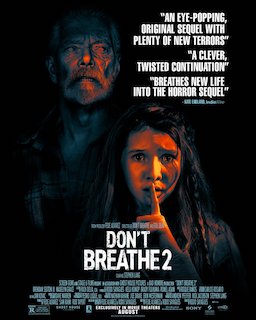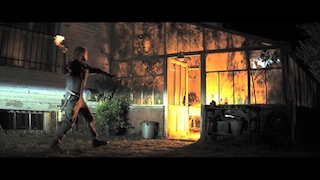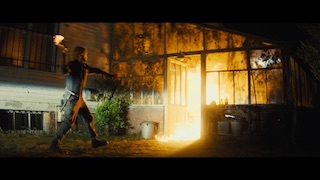 VFX Legion delivered more than one hundred visual effects for director Rodo Savagues’ action thriller, Don’t Breathe 2, which was released theatrically August 13th. The franchise was born from the creative partnership of Savagues and Fede Alvare, the director of the highly successful first installment, Don’t Breathe, in 2016. Visual effects were key to bringing co-writers Savagues and Alvare’s vision of the sequel to life. Complex computer-generated sequences and digital shots were relied on to augment imagery captured on practical footage, elevating the visceral emotions elicited by the atmospheric thriller.
VFX Legion delivered more than one hundred visual effects for director Rodo Savagues’ action thriller, Don’t Breathe 2, which was released theatrically August 13th. The franchise was born from the creative partnership of Savagues and Fede Alvare, the director of the highly successful first installment, Don’t Breathe, in 2016. Visual effects were key to bringing co-writers Savagues and Alvare’s vision of the sequel to life. Complex computer-generated sequences and digital shots were relied on to augment imagery captured on practical footage, elevating the visceral emotions elicited by the atmospheric thriller.
In the original film, three men break into the home of the blind man, Norman Nordstrom (Stephan Lang) expecting an easy score. Instead, they’re slaughtered by a combat-trained veteran with acutely heightened senses. The sequel picks up the story six years later, with Lang, reprising his role. Now living in isolation with an orphaned girl he took in, their quiet existence is shattered when the child is kidnapped. Using his formable skills, the protagonist sets out to rescue the girl and take revenge on her captors.
Shot in Belgrade, Serbia, and Detroit in the fall of 2020, the pandemic slowed down production of the film considerably. A looming release date put pressure on post-production. When it became clear that the original visual effects vendor lacked the resources to meet the film’s needs, shots were spread out among numerous visual effect companies. Legion was asked to bid on more than thirty effects and initially awarded just a handful of the most complex shots.
 Within days of beginning the job, the studio began contacting Legion to bid on more work. The company was awarded nearly all the effects for a big sequence that called for a variety of complex effects. Working as a collaborative team, VFX Legion created raging fires, time warps, fluid dynamics, split screens, and CG muzzle flashes, along with other shots required for the scene.
Within days of beginning the job, the studio began contacting Legion to bid on more work. The company was awarded nearly all the effects for a big sequence that called for a variety of complex effects. Working as a collaborative team, VFX Legion created raging fires, time warps, fluid dynamics, split screens, and CG muzzle flashes, along with other shots required for the scene.
“The quality of the intricate, multi-layered shots that we produced exceeded the client’s expectations, dramatically elevating the look of the original digital effects while meeting a tight deadline,” says James David Hattin, Legion’s founder and VFX supervisor. “Our initial work on the film gave us the opportunity to earn the client’s trust which led to Legion being brought on board as one of the primary visual effects vendors and ultimately, delivering over 100 shots for the film.”
The massive opening shot of the movie, well over 1500 frames long, incorporates a wide range of effects. Legion created a fully CG double of an actress, custom graffiti, computer-generated overgrown foliage, and integrated digital elements into the footage.
 The film includes 40 digitally ignited fire sequences in total. The complexity and dynamics of these effects would have made building them from scratch a costly and time-consuming process. VFX Legion’s association with ActionVFX, a stock visual effect company with a vast archive, enabled its team to provide an efficient alternative. Artists found stock fires that were the right fit for all but one of the 40 shots. Legion’s team digitally augmented the stock elements to work with the practical footage, seamlessly blending them into the film.
The film includes 40 digitally ignited fire sequences in total. The complexity and dynamics of these effects would have made building them from scratch a costly and time-consuming process. VFX Legion’s association with ActionVFX, a stock visual effect company with a vast archive, enabled its team to provide an efficient alternative. Artists found stock fires that were the right fit for all but one of the 40 shots. Legion’s team digitally augmented the stock elements to work with the practical footage, seamlessly blending them into the film.
During one scene the protagonist sets a house on fire, with some digital help. Towards the end of the movie, Nordstrom is desperately trying to find a way out of that house as the intensity of the CG flames grows, virtually consuming the structure. Using Autodesk’s Maya, artists digitally crumble the floors as The Blind Man makes his way through the flames and embers to a window and dives out, escaping the inferno.
“The client was also thrilled with the ongoing immediate access they had to Legion’s team. The level of communications that we considered essential to our brand of visual effect services was a game-changer for the production,” says Hattin, “It made working with us a seamless, stress-free experience while maximizing efficiency and fast-tracking deliverables. Rodo was several continents and time zones away but was always available to give us feedback responsively to make the final shots better than ever.”
